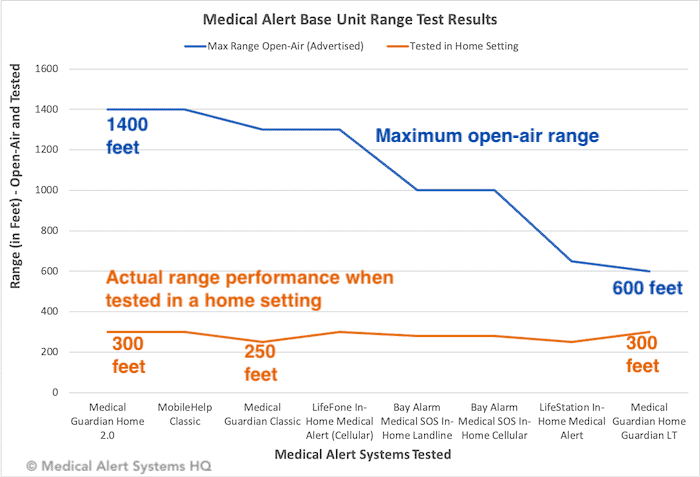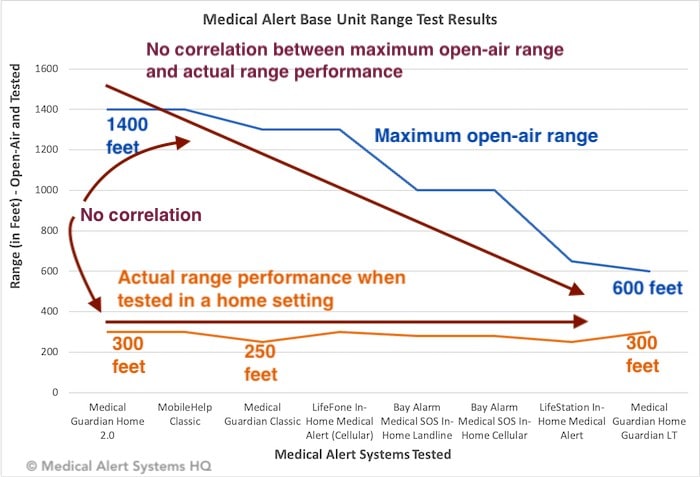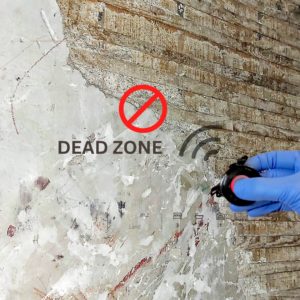Last Updated on October 12, 2023

The range of a medical alert system is often quoted in marketing materials to justify why one system is “better” than another. But is it really?
Curious, we tested this hands-on. Contrary to popular logic, we found that long-range systems with higher advertised range limits do not always perform better when tested in a real-life residential setting. See our range test results table below.
In addition, and fortunately, most top-tier systems will offer more than sufficient range for home users irrespective of their maximum range specifications.

Due to these two factors, a higher range may not do much to improve a product user’s actual medical alert system range experience. The next time you hear someone emphasize range as an important decision-making factor, take it with a grain of salt.
Here are our findings to illustrate further.
Medical Alert Systems Range Test Results Table
| Max Range Open-Air (in feet) | Max Range when Tested (in feet) | |
|---|---|---|
| Medical Guardian Home 2.0 | 1400 | 300 |
| MobileHelp Classic | 1400 | 300 |
| Medical Guardian Classic | 1300 | 250 |
| LifeFone In-Home Medical Alert (Cellular) | 1300 | 300 |
| Bay Alarm Medical SOS In-Home Landline | 1000 | 280 |
| Bay Alarm Medical SOS In-Home Cellular | 1000 | 280 |
| LifeStation In-Home Medical Alert | 650 | 250 |
| Medical Guardian Home Guardian LT | 600 | 300 |
| Life Alert (Help Pers LTE) | NA | 310 |
| Lifeline HomeSafe (Landline) | NA | 250 |
| Average | 1081 | 283 |
Source: Original medical alert systems test results by Medical Alert Systems HQ.
The maximum range when tested is much lower than the advertised maximum open-air range. Testing was done in a residential environment with obstacles and signal interference from walls and electronic devices.
The above tests are performed to measure the remote activation range between an in-home base unit and its paired a medical alert button. This could be for in-home landline and non-landline systems.
Note that nowadays, there are all-in-one mobile medical alert devices like the LifeFone VIPx and Medical Guardian MG Mini. They are small enough to be worn and do not need to be remotely activated. These are cellular devices that will dial the monitoring center directly, both in and out of the home.
Systems With Lower Maximum Ranges Reached Just As Far
We found that some systems with lower maximum range limits performed just as well as systems with longer range limits.
For example Medical Guardian’s Home 2.0 system has an advertised maximum range of 1400 fee, while their older Home Guardian LT system has an advertised range of 600 feet (less than half the range of Home 2.0).
Yet when we tested both systems out in a residential setting, their actual range performance results turned out to be similar. In our test environment, both systems faded out in signal reception at around 300 feet.
Actual Range Performance Much Lower Than Open-Air Range
The actual range performance for an in-home medical alert system is on average 26% of its maximum open-air range based on our test.
Average Open-Air Range maximum – 1081 Feet
Average Actual Range performance maximum – 283 Feet
Percentage of Actual Range Performance to Open-Air Range – 26%
Open-Air vs. At Home Test Settings
It is not surprising for a system to perform at a much lower level in an actual residence as compared to in an open-air test environment.
Open-air test environments are very different from real-life environments in homes. Open-air environments are free of obstacles (eg. walls, mirrors, metal objects) that are present in typical home environments. The presence of obstacles along the path will weaken the transmission of signals.
With most systems, we found that their remote activation reach maxed out in the 250 feet to 300 feet range in our test home environments.
To put things in context, even a 250 to 300-foot range provides more than comprehensive coverage for most homes. That’s almost the length of a football field (300 feet).
Every home setting is different, so it is imperative to test your system out.
No Correlation Between Actual and Maximum Range
In addition to the real-life range number being much lower, there is no correlation between the actual range performance measured in a residential setting (with walls and other interferences), and its advertised maximum range (based on open field test conditions).

If you look at the test results chart again, the first line (open-air range) slopes downwards, but the lower line (actual tested range) is almost flat and fluctuating between 250 to 300 feet. If there’s any correlation, one would expect the lines to have the same slope.
Consider these numbers.
LifeFone In-Home Medical Alert (Cellular): tested at home 300 feet maximum performance vs. open-air test environment 1300 feet maximum
Bay Alarm Medical SOS Home: home tested 280 feet vs. open-air 1300 feet max
LifeStation In-Home: home tested 250 feet vs. open-air 650 feet max
Medical Guardian’s Home Guardian LT: home tested 300 feet vs. open-air 600 feet max
Based on our test results, a higher advertised open-air range number did not significantly improve the actual product performance. However, it makes for a better product advertisement.
Blind Spots & Dead Zones
What could be worrying is the presence of obstacles that block the signals. These can cause blind spots and dead zones to occur at different places at home, EVEN IF these spots are within the scope of the real-life tested range perimeter.
When this occurs, it doesn’t matter what the range is. Your signals may not transmit successfully. Here’s an example:
In one residential test setting, we found that an area behind a concrete brick partition blocked off remote activations. This was despite this dead zone being about 100 feet away from the base unit, while the maximum tested ranges were in the 200 to 300 feet range.
The brick partition blocked off signals for all medical alert buttons being tested, regardless of their real-life or open-air maximum ranges.
If we were to move further away from the wall (and the base unit), the signals would get through again.
As such, it is best to regularly test the system’s range coverage at your home. That way, you can find out where the trouble spots are in your home setting.
Here is a list of the best long range medical alert systems on the market today.
In a hurry? Leave us your email, we’ll follow-up with the best tips.


